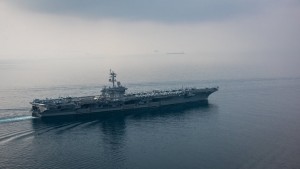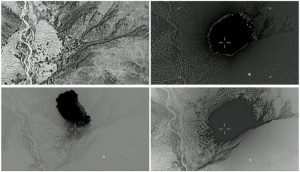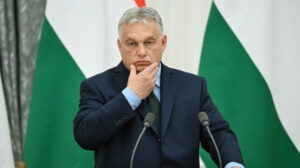When Adm. Harry B. Harris Jr., the military’s top commander in the Pacific, ordered the aircraft carrier Carl Vinson “to sail north” from Singapore this month, he was oblivious to the larger — and incorrect — impression that he was rushing a naval strike force to confront an increasingly belligerent North Korea.
Four days later, when Gen. John W. Nicholson Jr. dropped the most powerful conventional weapon in the American arsenal on Islamic State fighters in a tunnel complex in eastern Afghanistan, he not only seized headlines around the world but also unintentionally signaled to dictators in Syria and North Korea that they might be the next target of what the Pentagon called the “mother of all bombs.”
Instead of simply achieving tactical objectives, the timing of their actions surprised their bosses at the Pentagon, upset edgy allies and caught the White House flat-footed. Taken together, the episodes illustrate how even the military’s most seasoned four-star field commanders can fail to consider the broader political or strategic ramifications of their operational decisions, and some current and former senior officials suggested that President Trump’s decision to unshackle the military from Obama-era constraints to intensify the fight against terrorists risked even more miscues.
“There are lots of decisions that military commanders make every day on their own without asking, ‘Mother, may I?’” said Robert M. Scher, a former senior Pentagon official. “But they have to realize and take into account that their actions can have strategic impact outside of their areas of responsibility.”
American officials said Thursday that General Nicholson had not requested permission from Mr. Trump, Defense Secretary Jim Mattis or Gen. Joseph F. Dunford Jr., chairman of the Joint Chiefs of Staff, before dropping the giant bomb, a GBU-43/B Massive Ordnance Air Blast, or MOAB.
And it does not appear the White House was aware of the location of the carrier group when the press secretary, Sean Spicer, or the national security adviser, Lt. Gen. H.R. McMaster, made their public comments about it. White House officials said both men were relying on talking points supplied by the Pentagon.
General Nicholson already had the necessary authority to bomb the tunnel complex and had it during the Obama administration as well, American officials said.
But current and former Defense Department officials said that if President Barack Obama were still in office, General Nicholson would probably have checked with his bosses before calling in the country’s most powerful non-nuclear bomb, because the Obama White House had made clear to the Pentagon that the president wanted to be consulted on major strike decisions.
“Nicholson should have been a little more aware that using that weapon for the first time would be a big story,” Mr. Scher said.
Mr. Trump has made clear that he does not want to be consulted on every strike, and that he wants commanders in the field to have more authority to move swiftly against foes.
The timing of the episodes, at the beginning of the Trump administration, most likely played a part, one Obama administration official noted.
“Once the previous administration’s political appointees have departed, the balance of power in the Pentagon always shifts away from the civilians and toward the uniformed officers,” said Andrew Exum, a former Army Ranger and top Pentagon Middle East policy official.
“That’s not necessarily dangerous, but until you get the new administration’s team in place, you miss the policy oversight that can sometimes help field commanders — who are appropriately focused on operations — think through the political and strategic ramifications of their actions.”
The bomb was dropped at an already fraught time for American security, with a narrative that had begun to take hold of an untethered Pentagon, freed from Obama-era restrictions.
Only days earlier, the United States had fired dozens of missiles at the airfield in Syria from which President Bashar al-Assad had launched a chemical weapons attack. (Mr. Trump authorized that strike.)
And the country was bracing for a possible showdown with Pyongyang as the North Korean leader, Kim Jong-un, was expected to launch another missile test amid incorrect talk from Mr. Trump that an American “armada” was headed toward the Korean Peninsula.
In that atmosphere, the announcement on April 13 that the United States had just dropped the MOAB was itself a dramatic development and was interpreted by many news organizations and national security experts as evidence that the Trump administration was sending Mr. Kim, or Mr. Assad, a message.
That was not so — an American commander in Afghanistan had simply taken it upon himself to use a particularly large bomb on a cave complex in the remote province of Nangarhar.
“Commanders always want more freedom to act within their own judgment,” said Adm. James A. Winnefeld, a retired vice chairman of the Joint Chiefs of Staff. “Sometimes those same commanders may not sense which of their decisions will bleed over into the strategic level.”
Asked Thursday whether General Nicholson had discussed the bombing with him beforehand and considered the larger strategic message he was sending, Mr. Mattis said, “We take into account the strategic effect of everything we do.”
(A combination of still images taken from a video released by the Department of Defense showing the explosion of Massive Ordnance Air Blast, or MOAB, in Afghanistan recently)
In Tel Aviv, speaking with reporters who have been traveling with him throughout the Middle East this week, Mr. Mattis said that over all, he had been kept informed on the war effort in Afghanistan. But, he added, “You have to delegate.”
He did not criticize General Nicholson publicly. But one Defense Department official, who was not authorized to speak publicly, said that Mr. Mattis had questioned the purpose of the strike afterward.
In fact, the Pentagon still has not assessed how much damage was done by the bombing, a routine step after major strikes in Syria and Iraq. Afghan officials initially said that they believed only 36 Islamic State fighters had been killed, but they have since revised that number to just under 100. Afghan forces are still battling Islamic State fighters in the area.
Asked why no damage assessment had been done, Mr. Mattis said, “Frankly, digging into tunnels to count dead bodies is not a good use of our troops’ time.”
For the wayward Carl Vinson, the confusion began on April 9 when the public affairs office of the Navy’s Third Fleet issued a news release saying that Admiral Harris had ordered the Carl Vinson, a Nimitz-class nuclear-powered carrier, and its strike force — two destroyers and one cruiser — to leave Singapore and “sail north” to the Western Pacific.
As is customary, the Navy did not say exactly where the carrier force was headed, when it would get there or its precise mission.
Navy officials said the main reason for issuing the release was to alert the families of thousands of sailors that Admiral Harris had also canceled a port call for the ships in Fremantle, Australia, where many relatives were planning to meet their loved ones.
Admiral Harris feared that images of sailors on shore leave would be unseemly at a time when North Korea was firing missiles, Navy officials said.
But the news release omitted any mention of a secretive naval exercise with Australia that Admiral Harris never meant to suggest he was canceling, Navy officials said.
Thus, once the Carl Vinson left Singapore on April 8, it actually sailed south, toward the Indian Ocean, the opposite direction Admiral Harris had said it was going.
At that point, some Pentagon officials said on Thursday, it would have been embarrassing and possibly damaging to American interests to publicly correct the narrative and send mixed messages to the North Koreans. But some former officials disagreed.
“Words matter, and there will be a cost to U.S. credibility in Asia for this mistake,” said Brian McKeon, the Pentagon’s top policy official at the end of the Obama administration. “Given the stakes, senior officials should have taken greater care to understand the facts, and to correct the record once they learned them.”
Ask me anything
Explore related questions






